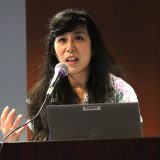Keeping Indigenous Languages Alive Professor Discusses the Relevance of Speaking Amazonian Languages
January 28, 2020

Dr. Valenzuela accompanied by Nopoki University faculty. From left to right, teachers from the following ethnic groups: Nomatsiguenga, Yanesha’, Ashaninka, Shipibo, and the University’s president.
Did you know that there are roughly 6,909 spoken languages in the world today (according to https://www.linguisticsociety.org)? However, about 2,000 of those languages have fewer than 1,000 speakers?
Mind-blown?
There are over 2,000 languages endangered today and that count changes constantly. A language becomes endangered when its users begin to teach and speak a more dominant language to their children.
Dr. Pilar Valezuela, Professor in the Department of World Languages and Cultures is a researcher and consultant in language development and intercultural bilingual education among the indigenous peoples of Peru and Bolivia and knows all about endangered languages. As part of the $344,690 NSF grant she was awarded (Computational Tool and Corpora Development in a Language with Complex Clause-marking) she traveled to the town of Atalaya, in the Peruvian Amazon where she was invited as the keynote speaker in the activities celebrating the “Intercultural Bilingual Education Week” at the Indigenous University Nopoki, a university for indigenous students in the Peruvian Amazon.
Dr. Valenzuela’s talk dealt with the relevance of speaking and investigating indigenous Amazonian languages in the 21st century. Some of the topics she focused on were the key roles of language to maintain a distinct identity as indigenous people, how historical linguistics can help to better understand Amazonian peoples’ past, and the need to train more local linguists to contribute in the implementation of intercultural bilingual education.
Faculty and students from 18 different indigenous groups, speaking the same number of different languages, actively participated in the questions and answers following her presentation. One of the main topics discussed was how to keep indigenous languages alive, in particular, how to encourage young people to continue speaking their Native languages.


